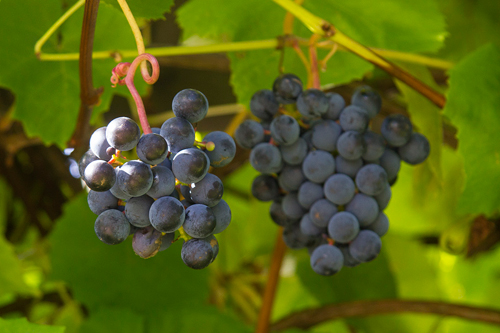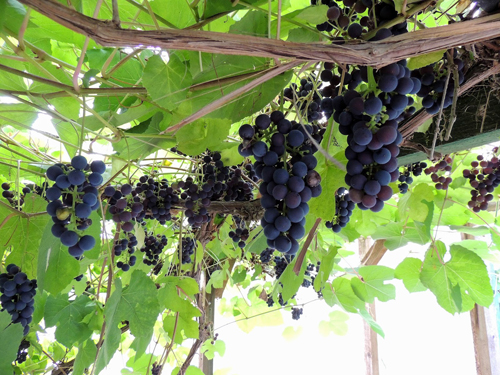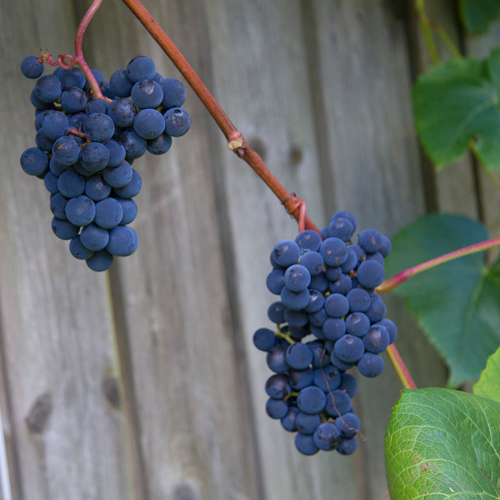Zilga grape variety
Zilga is a hybrid form of dark colored grapes for universal use, originally from Latvia. It was bred in the second half of the last century by a talented gardener of the Michurin collective farm, Daugavpils region - Paul Sukatniek. The new variety was obtained by fertilizing the flowers of the half Amur variety Smuglyanka with a mixture of pollen from the interspecific hybrids Dvietes zila ("Divine Blue") and Yubileiny Novgorod.
The paternal genes of the resistant American species Vitis labrusca were inherited by our heroine, which determined her excellent resistance to major fungal diseases and increased frost resistance. However, along with high economic qualities, it also inherited specific, purely "Labrusk" traits, including the slimy pulp of berries and strawberry tones in the aroma, which some gourmets consider to be signs of almost bad taste.

In addition to its characteristic unpretentiousness, this grape is also distinguished by a very early ripening period, which, in principle, determined its popularity among amateurs from non-traditional regions of viticulture. Currently, the variety is widespread in the Baltic countries - Latvia, Lithuania and Estonia, and is also found in Belarus, Norway, Sweden, and even Canada and the United States. In Russia, Zilga is not very popular, more often it is present in the assortment of amateurs in the regions bordering the Baltic states.
Agrobiological characteristics
Plants are characterized by high vigor. Powerful shoots, greenish-burgundy color. The leaves are dark green, large, rounded, three- and five-lobed, moderately dissected. The surface of the leaf is reticulate-wrinkled, somewhat coarse. The profile is funnel-shaped, less often wavy. The upper lateral incisions are of medium depth, mostly open, lyre-shaped with a rounded bottom, sometimes slit-like or in the form of a reentrant angle. The bottom notches are usually absent, but may be barely outlined. The petiolate notch is either open or closed. In the first case, it takes a lyre-like shape, in the second, the lumen is practically invisible, or it is narrowly elliptical. The petioles are long, thin, greenish-pink due to the presence of anthocyanin pigmentation. The denticles along the edges of the leaf blade of grapes are small, saw-shaped, or domed. The flowers are bisexual, due to which the pollination of the variety occurs fully and practically does not depend on the vagaries of the weather. For this reason, the berries are not prone to peas, and the brushes are not prone to excessive loosening. Annual growth ripens perfectly, while the shoots acquire a bright, reddish-brown color.
Zilga bunches grow above average in size, dense, cylindrical in shape, often with a wing. The average mass of a ripe brush ranges from 320-400 grams. The combs are short, herbaceous, but strong enough, their color is similar to the color of the leaf petioles. The berries are large, weakly oval, densely covered with a gray protective waxy coating. The weight of 100 grapes is 410-430 grams. Squeezed and deformed berries can often be seen in knocked down bunches. In terms of size, they are quite aligned. The flesh is slimy, characteristic of isabelle grape varieties, with which the specific "fox" taste and aroma also indicate the relationship with which. Freshly squeezed juice is almost colorless, and its sugar content reaches high values, up to 22 g / 100 cubic meters. cm, with a very moderate level of titratable acidity of 4.5-5 g / cubic dm. The skin is thick, firm and firm. Chewed with some effort. The seeds are present, but it cannot be said that they sharply worsen the gastronomic qualities of the berries. The hybrid has an average tasting score of 7.1.

The directions of using the obtained harvest are very diverse, in connection with which Zilgu can be called a find for northern viticulture.It is equally well suited for food consumption and for processing into juice, compotes, preserves and jams. Home preservation, developed with its use, always has an elegant rich color and varietal aroma, which is perceived negatively only by especially sophisticated gourmets. Due to the high level of sugar accumulation, many winegrowers manage to make not the worst homemade wine out of it. This drink will also be characterized by light isable tones, but if it is not kept in a barrel for many years, then the “labrus” bouquet will not carry a negative perception for the vast majority of people.
The variety does not differ in special “marketability” and high indicators of marketability, being, first of all, grapes for own consumption. But, at the same time, one cannot fail to note its good transportability indicators, indicating the possibility of its transportation without damage over long distances, as well as its suitability for long-term storage. And if the first quality is of little use in the conditions of a private household, then the second can be useful to many.
One of the most remarkable properties of the Latvian heroine is the very early ripening of her fruits. The growing season from the time of budding until the grapes are ready for harvest lasts only 102-110 days. The sum of active temperatures required for plants during this time does not exceed 2150-2250 ° C. Naturally, with such low requirements, Zilga grows well and bears fruit in many northern regions of viticulture. Even at the latitude of the Leningrad Region, winegrowers manage to get yields of acceptable conditions and quality from it, let alone more southerly growing areas. An important point for cultivation in cold climates is the increased frost resistance of the vine of this variety. And although the indicator of -25 ° C is still insufficient for a non-covering culture in the north, it, one way or another, is useful even from the point of view of reducing the power of shelters, and therefore the laboriousness of the entire procedure.

In terms of yield, the hybrid does not claim to be records, although the high fruitfulness of shoots (80-85%) and a significant number of clusters on them (1.5-1.9) create all the prerequisites for excellent productivity indicators. In terms of numbers, up to 15 kilograms of grapes are harvested from well-developed bushes grown on a vertical trellis. Plants with a significant volume of perennial wood, characteristic of an arched or arbor culture, show higher results. Zilga is not prone to overloading, and therefore does not require the application of great efforts to normalize the yield.
Ripe bunches can hang on the vine for a long time without reducing their marketable and gastronomic qualities, and even vice versa, increasing them. As a result, the grapes reach full ripeness, while improving the conditions for sugar accumulation, which is one of the most important parameters on which the quality of the wine depends. And when eating berries, their additional sweetness will never be superfluous. Remaining on the bushes, the berries are not afraid of rotting or cracking, which can also be attributed to the unambiguous advantages of the variety. Even wasps rarely attempt to kill him, and only a few growers complain about a similar problem.
Agrotechnical features
The economic characteristics of Zilgi can hardly be considered standard in terms of unpretentiousness and adaptability to completely different cultivation conditions. Thanks to this, the hybrid can be recommended, including for novice winegrowers, who, even making some mistakes, will be able to get a decent harvest from the plants.
Despite the modest requirements for heat supply, the bushes should still be placed in areas heated by the sun. The slopes of the northern exposures, the lowlands of gullies, valleys, and other places with stagnant cold air are definitely not suitable for planting. In the northernmost regions with very short summers and close to the critical SAT level, grapes are grown in a wall culture protected from arctic winds.For large areas, southern slopes of sufficient steepness are sought, and a vineyard is laid out in their upper part. Balance must be shown in relation to the water regime of the soil. On the one hand, the variety responds well to sufficient moisture in the root layer, however, excessively damp, and even more so swampy areas are not suitable for it. It is also worth excluding places with a level of groundwater occurrence close to the surface. The feeding area should correspond to the planned dimensions of the bushes, and in this case, taking into account their high growth force, it is recommended not less than 4.5-5 sq. meters.
Reproduction most often occurs by rooted cuttings, since in areas where Zilgi is widespread, the soil is not infected with phylloxera. If the planting of grapes is planned in the southern regions where there is a risk of the presence of root aphids in the soil, the plants should be secured by grafting onto a phylloxera-resistant stock, or by using appropriate grafted seedlings. The variety's compatibility with the main rootstock forms, by the way, is good.
The choice between a covering and non-covering cultivation system should be made depending on the local climatic conditions, and, above all, the long-term minimum winter temperatures. It will be great if the frost resistance of the hybrid is enough to form powerful high-stemmed bushes, and even better for planting arches and arbors with them. In this case, you can count on excellent yields and improved fruit quality. If the thermometer in winter often overcomes the mark of -25 degrees, then willy-nilly it will be necessary to cover the grape bushes, and therefore to form them according to squat, standard-less schemes. The results of cultivation in this case will be more modest, but they will delight many winegrowers.
Pruning the plants that have entered fruiting is not difficult. Even the first buds of the variety are distinguished by high fertility, and therefore it is adapted for short pruning by 3-4 eyes, and in general, the load is carried out by 30-40 buds. With large-sized formings, this number can even be slightly increased. After the beginning of the growing season, sterile and weak shoots are broken off on the bushes so as not to consume nutrients for excess vegetative mass. It is not necessary to remove the inflorescences on the shoots of this grape.
Zilga demonstrates increased resistance to fungal diseases such as mildew, oidium and gray rot, and during the growing season requires only one or two preventive treatments against them. Thus, the harvest from the Latvian heroine can be considered environmentally friendly, which is also an undoubted advantage of her cultivation.








